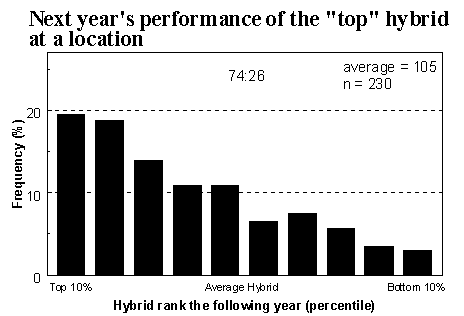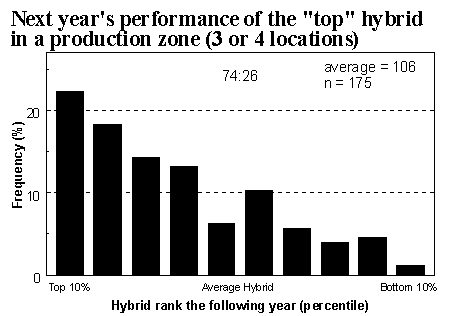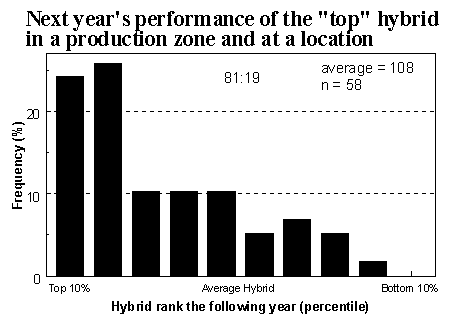December 1995
Field Crops 28.31-6
How Does the "Top" Corn Hybrid in a Trial Perform the Following Year?
Joe Lauer, Corn Agronomist
Farmers sometimes use hybrid trials to identify top performing hybrids for planting
on their farms the following year. Often farmers conduct their own on-farm trials.
Others use seed company trials, while still others rely on University trials or
some combination of trials. How good are these trials for predicting performance
of the top hybrid next year? After identifying the top hybrid at a location, what
are the chances it will be a top hybrid next year? Should a farmer conduct an on-farm
trial or rely on results from seed companies and Universities to predict hybrid
performance on-farm?
Performance data from University of Wisconsin Corn Hybrid Trials conducted between
1977 and 1995 were analyzed. The yield rank of a hybrid in one year was compared
with its yield rank in the trial the next year.
When a coin is flipped often enough, a 50:50 percent chance exists of getting either
"heads" or "tails." Likewise testing an "average"
hybrid results in a 49:51 percent chance that it will be either above or below the
trial average when grown the next year, ie. 49 percent chance of finishing above
the trial average and a 51 percent chance of finishing below the trial average (Figure
1). An "average" hybrid ranks in the top 10 percent of the hybrids of
a trial the following year about 7 percent of the time. However, an equal chance
exists for an "average" hybrid to rank in the bottom 10 percent of the
hybrids in a trial the following year. The "top" hybrid was selected and
ranked the next year in the same location and trial.

The "top" hybrids performed above the trial average 74 percent of the
time the following year (Figure 2). About 20 percent of the time, the top hybrid
ranked in the top 10 percent of the hybrids grown in the trial the following year.
Choosing the "top" hybrid at one location improved the chances of selecting
an above average hybrid the next year compared to selecting an "average"
hybrid (Figure 1). Can we improve upon this choice?

Figure 3 shows next year's performance of the "top" hybrid in a production
zone, ie. averaged across three or four locations. The "top" hybrid in
a zone performs above the trial average 74 percent of the time regardless of location.
This isn't much different from results of the "top" hybrid at one location
(Figure 2). However, a 22 percent chance exists for choosing a hybrid that will
be in the top 10 percent of the hybrids in a trial next year. Still, can we improve
our decision?

Next year's performance of hybrids that were ranked at the "top" for both
location and production zone is shown in Figure 4. The "top" hybrid in
a zone and location performs above the trial average 81 percent of the time and
a 24 percent chance exists for choosing a hybrid in the top 10 percent of the trial
and a 50 percent chance that it will finish in the top 20 percent of the hybrids
in a trial.

"Average" hybrid performance in one year often leads to average performance
the following year, ie. 49:51 percent chance of beating the trial average. Choosing
the "top" hybrid at one location improved the chances of selecting an
above average hybrid the next year for that location, ie. 74:26 percent chance of
beating the trial average. Choosing the "top" hybrid averaged across many
locations, or a production zone, also increased the chances of beating and "average"
hybrid, ie. 74:26 percent chance of beating the trial average. The best way to increase
the chances of picking a hybrid with high performance the next year was to select
the "top" hybrid based on performance in both a production zone and location,
ie. 81:19 percent chance of beating the trial average.
The likelihood of choosing a hybrid performing in the top 10 percent of hybrids
grown next year increases from 7 to 20 to 22 to 24 percent as hybrids were selected
based on performance of "average" hybrids at one location, "top"
hybrid at one location, "top" hybrid in a production zone, and "top"
hybrid in a zone and at one location, respectively. A well-conducted hybrid trial
on-farm or at one nearby location increases the chances of selecting a hybrid which
will perform above the trial average the following year. However, for picking a
hybrid to finish in the top 10 percent of the hybrids tested next year, the chances
are best when average performance across many locations and management conditions
is considered. Since most farmers do not have the resources to conduct on-farm trials
at several locations, using unbiased results from other trials to supplement on-farm
yield results can increase the chance of picking a hybrid that will do well next
year.